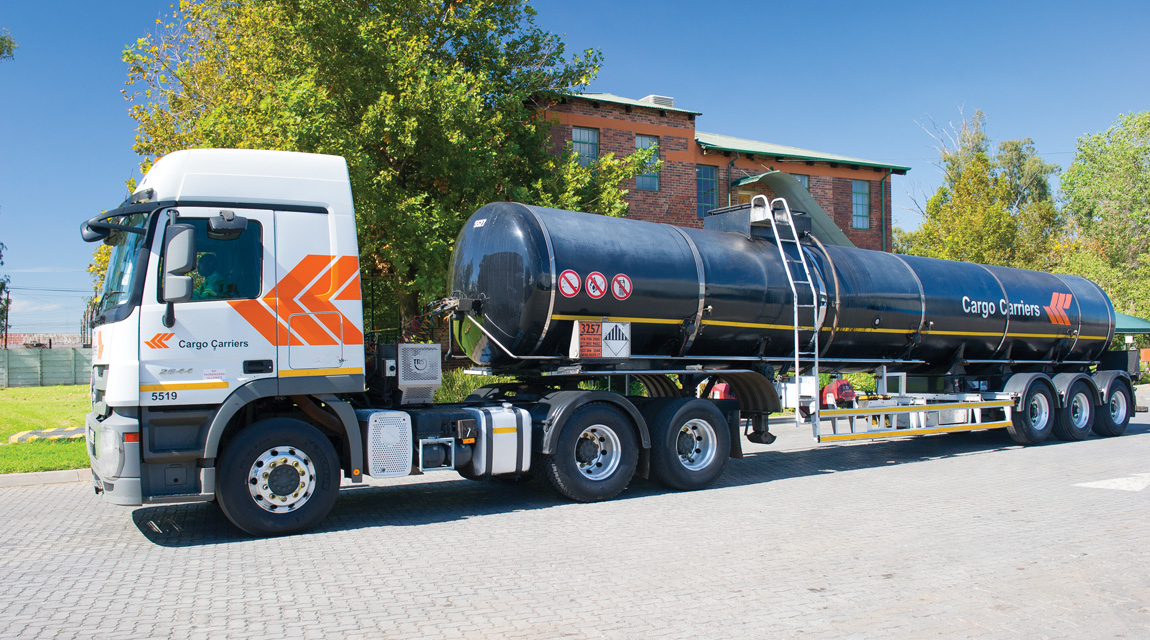Secret to a superb fleet

Well known for its role in transporting hazardous goods, Cargo Carriers also moves steel, sugar and mining aggregates and offers supply chain solutions. With such a diverse portfolio, how does this operator keep on top of it all?
The Cargo Carriers fleet currently consists of 250 truck tractors and a trailing fleet of 158 tri-axle trailers, 55 interlinks and other specialised trailing units. These vehicles serve customers across eight specialised logistics units and, considering most of them require the transportation of some form of hazardous substance, the job is not taken lightly.
Andre Jansen van Vuuren, marketing director at Cargo Carriers, explains that the company’s philosophy for effective fleet management places the following above all else: payload, vehicle tracking, limited hours for drivers (not more than 15), driver wellness campaigns, route surveys, fuel consumption and on-time deliveries.
To achieve this, the company follows strict programmes in repair and maintenance, driver training and digital solutions. Among these, the driver training is probably the most important.
“The training is constantly reviewed and updated to ensure our drivers are aware of changes in legislation and all aspects of their responsibilities. Training in defensive driving is provided and drivers are evaluated by skilled driver trainers both on the road and in the classroom,” explains Jansen van Vuuren.
“All the individuals undergoing training are fully educated on safety, health, environment and quality (SHEQ) requirements, and receive the best knowledge transfer possible,” he adds.
Extensive training is also conducted in terms of the conveyance of dangerous goods by road (hazchem training); firefighting; operating vehicle combinations and rollover prevention.
“Maintaining the fleet in tip-top condition is not negotiable,” says Jansen van Vuuren. “There is a proper maintenance programme in place with a history of failure trends that are analysed. A tyre policy helps to generate the best cost per kilometre and tyre lifecycle. This ensures that vehicles are roadworthy at all times and maximum uptime and productivity of the fleet is achieved.”
The company’s vehicle-replacement policy dictates that vehicles are replaced every three to five years, depending on operation. Of course, keeping tabs on vehicles, drivers and cargo means it can offer world-class service to its clients. All vehicles are equipped with a cellphone and satellite tracking for real-time positioning and control. Ctrack has been the fleet-management provider of choice for the past 15 years.
“Position reporting intervals, speed and more than 20 other status parameters are reported on,” says Jansen van Vuuren.
Furthermore, Cargo Carriers has made a substantial investment in information technology over the past 15 years, integrating fundamental software applications in all areas of the business.
“In the niche market in which we operate, we utilise a suite of specialised software applications. These consist of advanced-planning and scheduling, route-optimising, maintenance-management, transport-management and fuel-management systems,” we’re told.
With each aspect brought together under the strictest control, Cargo Carriers continues to build its reputation as a hazchem transporter of distinction.
Published by
Focus on Transport
focusmagsa




